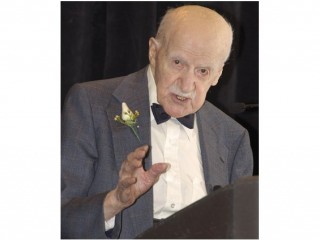
Joseph M. Juran biography
Date of birth : 1904-12-24
Date of death : 2008-02-28
Birthplace : Braila, Romania
Nationality : Romanian
Category : Science and Technology
Last modified : 2011-12-20
Credited as : management consultant, The Pareto Principle, Juran's trilogy
1 votes so far
Juran was born to a Jewish family in 1904 in Brăila, Romania, and later lived in Gura Humorului. In 1912, he immigrated to America with his family, settling in Minneapolis, Minnesota. Juran excelled in school, especially in mathematics. He was a chess champion at an early age, and dominated chess at Western Electric. Juran graduated from Minneapolis South High School in 1920.
In 1924, with a bachelor's degree in electrical engineering from the University of Minnesota, Juran joined Western Electric's Hawthorne Works. His first job was troubleshooting in the Complaint Department.In 1925, Bell Labs proposed that Hawthorne Works personnel be trained in its newly-developed statistical sampling and control chart techniques. Juran was chosen to join the Inspection Statistical Department, a small group of engineers charged with applying and disseminating Bell Labs' statistical quality control innovations. This highly-visible position fueled Juran's rapid ascent in the organization and the course of his later career.
In 1926, he married Sadie Shapiro, and they had four children: Charles, Donald, Robert, Sylvia. They had been married for over 81 years when he died in 2008.
Juran was promoted to department chief in 1928, and the following year became a division chief. He published his first quality related article in Mechanical Engineering in 1935. In 1937, he moved to Western Electric/AT&T's headquarters in New York City.
As a hedge against the uncertainties of the Great Depression, he enrolled in Loyola University Chicago School of Law in 1931. He graduated in 1935 and was admitted to the Illinois bar in 1936, though he never practiced law.
During the Second World War, through an arrangement with his employer, Juran served in the Lend-Lease Administration and Foreign Economic Administration. Just before war's end, he resigned from Western Electric, and his government post, intending to become a freelance consultant. He joined the faculty of New York University as an adjunct Professor in the Department of Industrial Engineering, where he taught courses in quality control and ran round table seminars for executives. He also worked through a small management consulting firm on projects for Gilette, Hamilton Watch Company and Borg-Warner. After the firm's owner's sudden death, Juran began his own independent practice, from which he made a comfortable living until his retirement in the late 1990s. His early clients included the now defunct Bigelow-Sanford Carpet Company, the Koppers Company, the International Latex Company, Bausch & Lomb and General Foods.
The end of World War II compelled Japan to change its focus from becoming a military power to becoming an economic one. Despite Japan's ability to compete on price, its consumer goods manufacturers suffered from a long-established reputation of poor quality. The first edition of Juran's Quality Control Handbook in 1951 attracted the attention of the Japanese Union of Scientists and Engineers (JUSE) which invited him to Japan in 1952. When he finally arrived in Japan in 1954 Juran met with ten manufacturing companies, notably Showa Denko, Nippon Kōgaku, Noritake, and Takeda Pharmaceutical Company. He also lectured at Hakone, Waseda University, Ōsaka, and Kōyasan. During his life he made ten visits to Japan, the last in 1990.
Working independently of W. Edwards Deming (who focused on the use of statistical process control), Juran—who focused on managing for quality—went to Japan and started courses (1954) in Quality Management. The training started with top and middle management. The idea that top and middle management needed training had found resistance in the United States. For Japan, it would take some 20 years for the training to pay off. In the 1970s, Japanese products began to be seen as the leaders in quality. This sparked a crisis in the United States due to quality issues in the 1980's.
In 1941 Juran stumbled across the work of Vilfredo Pareto and began to apply the Pareto principle to quality issues (for example, 80% of a problem is caused by 20% of the causes). This is also known as "the vital few and the trivial many". In later years Juran preferred "the vital few and the useful many" to signal that the remaining 80% of the causes should not be totally ignored.
When he began his career in the 1920s the principal focus in quality management was on the quality of the end, or finished, product. The tools used were from the Bell system of acceptance sampling, inspection plans, and control charts. The ideas of Frederick Winslow Taylor dominated.
Juran is widely credited for adding the human dimension to quality management. He pushed for the education and training of managers. For Juran, human relations problems were the ones to isolate. Resistance to change—or, in his terms, cultural resistance—was the root cause of quality issues. Juran credits Margaret Mead's book Cultural Patterns and Technical Change for illuminating the core problem in reforming business quality. He wrote Managerial Breakthrough, which was published in 1964, outlining the issue.
He also developed the "Juran's trilogy," an approach to cross-functional management that is composed of three managerial processes: quality planning, quality control and quality improvement. These functions all play a vital role when evaluating quality.
















